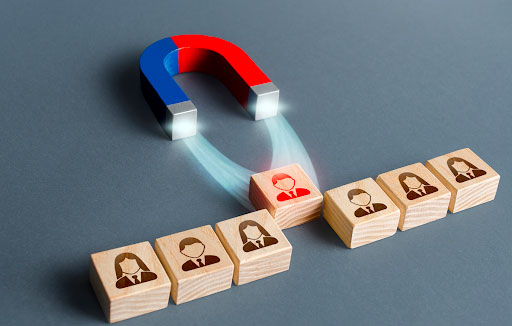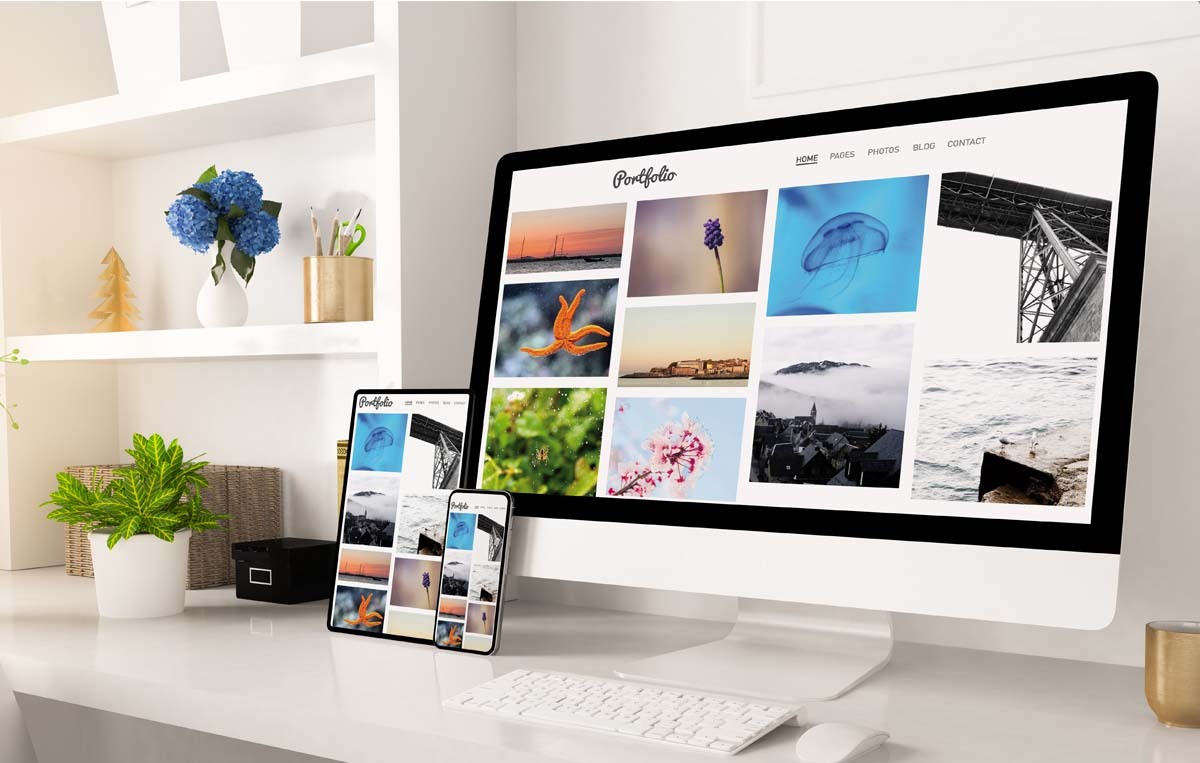As a marketing agency, you know how important it is to attract new customers. However, retaining your existing customers is just as crucial to your success.
Customer retention not only helps you to maintain a steady revenue stream, but it can also be more cost-effective than constantly acquiring new customers.
To help you keep your customers coming back for more, we’ve put together a list of eight customer retention techniques that your agency can implement and even attract new ones to grow your business.
We’ll start methodically by reviewing the customer retention metrics you must follow and then discuss the best strategies to improve those metrics, analyzing plenty of examples* to give you new, exciting ideas.
Keep reading below.
*These examples aren’t compiled from other agencies’ activity because few agencies are fructifying these techniques. However, these examples run across industries and can prove amazing inspiration sources.
Why Is Customer Retention Important?
Customer retention refers to the practice of keeping your existing customers. Intuitively, you don’t want customers running to the competition, least of all after trying your products. But if you need more explanation and numbers, look at the benefits below:
More Valuable Orders
Having a high retention rate means you’ve earned your audience’s trust. These loyal customers will have a tighter relationship with your brand and spend more money in your store. Even better, they are more likely to purchase other items from your sibling companies.
Here are the numbers:
- Existing customers account for an average of 65% of most companies’ profits
- A 5% retention rate increase leads to a 25-95% profit increase
Cheaper Than Onboarding New Customers
Studies also show customer retention is more cost-effective than finding a new audience. In fact, it’s 5x more expensive to address new customers than to keep your old ones.
More Referrals
These people who get to know, trust, and purchase from your brand are your best ambassadors.
Statistics show that 88% of shoppers trust word-of-mouth, compared to 4% who trust branded content. These people who believe your products are valuable will likely recommend them further. 94% will recommend your brand if they rate your service as “very good.” They will also engage with your brand on social media more, thus increasing your visibility and reach.
The end result? More sales!
Valuable Database of Customer Info
These long-term customers are essential because they help you build a valuable database with their info. This database is a crucial source of:
- Insights into your customers’ subconscious minds and behaviors
- Current trends in the market
Armed with this info, you can improve your products and brand communication to retain even more prospects.
5 Customer Retention Metrics
Customer retention is key for a flourishing business, but it’s not an esoteric concept or something that just happens. You must pursue it with actionable plans and measure your results through quantifiable metrics. You also need to have the correct picture before getting anything started.
1. Repeat Customer Rate
The repeat customer rate is calculated following this formula:
RCR = Number of repeat customers/Number of one-time customers
The higher this rate, the better your customer retention.
2. Purchase Frequency
Purchase frequency tells you how often people are buying from your brand. A high purchase frequency indicates that your brand sells continuously without hiccups.
PF = Number of orders/Number of customers
3. Average Order Value
Frequent sales are essential, but the transactions should also be valuable enough to increase your overall ROI. That’s where the average order value comes in.
AOV = Total profit/Total number of orders
Remember: Some companies may focus on selling high-order tickets to fewer companies. Others may focus on numerous small-order items.
4. Customer Lifetime Value
To calculate how valuable a customer is to you, you must know their purchases’ frequency and value. The more often a client buys and the more expensive their purchases, the higher value they’ll bring.
CLV = Purchase frequency x Purchase value
Therefore, your customer retention strategy should entail increasing the purchase frequency and value across loyal customers.
5. Churn Rate
The churn rate represents the percentage of customers you have lost during a set period. Your goal should be minimizing that churn rate, so you must understand why it happens, which could be due to the following reasons or more:
- Poor customer experience
- High price compared to the competition
- Poorer service or products compared to the competition
- Expiry of a subscription-based product/service
CR in percent = (1 – Number of final customers/Number of initial customers) *100
Interesting read: 10+ Ways Small Businesses Can Improve Customer Retention
8 Customer Retention Techniques
Calculating these numbers for your specific case helps you understand what is not working in your case.
For example:
- You may have a decent churn rate, but your customers simply aren’t buying as frequently.
- You may have high-value orders from your repeat customers, but their frequency is low.
The eight customer retention techniques below address such issues, so choose the right one for your needs.
1. Keep in Touch With Your Customers
Keeping in touch with your customers helps you achieve multiple goals:
- It increases the number of purchases if the frequency is an issue: For example, you may discover that most people make purchases around the weekends or holidays. In this case, you can send them special offers to keep them interested for the rest of the year.
- It increases the repeat customer rate: You can increase the chances of people buying your products repeatedly if they remember you. Besides, sending them personalized recommendations and tutorials allows them to understand your products better, thus buying more frequently.
- It decreases churn rates: Keeping in touch with your customers allows you to ask them questions and learn from them. As a result, you can adapt your offers or improve your products. You can always send them other customized suggestions if they dislike one product from your range.
Personal stylist Ria Dixit offers a good example
She constantly keeps in touch with her customers through relevant content posted on social media.

Lessons learned:
- Stay top of mind by sending customers occasional updates or special offers.
- Collect customer feedback to send better (more personalized) offers or improve your product/delivery/communication.
- Send them tailored product recommendations.
- Show people customized product tutorials.
- Leverage social media channels and marketing emails to keep in touch with your prospects.
2. Start a Referral Program
Ask for referrals and testimonials from happy customers to help promote your business. This strategy leverages your repeat customers, who will recommend new ones. Of course, you would have to incentivize them using discounts or special offers.
Logical conundrum: If you’ve been paying attention to the math we did in the previous question, you may ask yourself these questions:
- Doesn’t this strategy bring new one-time customers?
- And doesn’t that, in turn, decrease the repeat customer rate, which is calculated by dividing the number of repeat customers by the number of unique ones?
Sure, people can recommend your products to others just to reap those discounts. But if your service is poor, you won’t get many repeats.
Solution: The solution is to ensure these new prospects become repeat customers.
So when you start a referral program, ensure your brand and products can keep people around. As a result:
- Your repeat customer rate increases: Keep your product quality high to secure more customers over the long term.
- Your purchase frequency increases: Those discounts and incentives used in the referral program will make people more likely to purchase repeatedly.
Dropbox’s referral program is a good example because its incentives are very tempting, which helps them stand out from its competition.
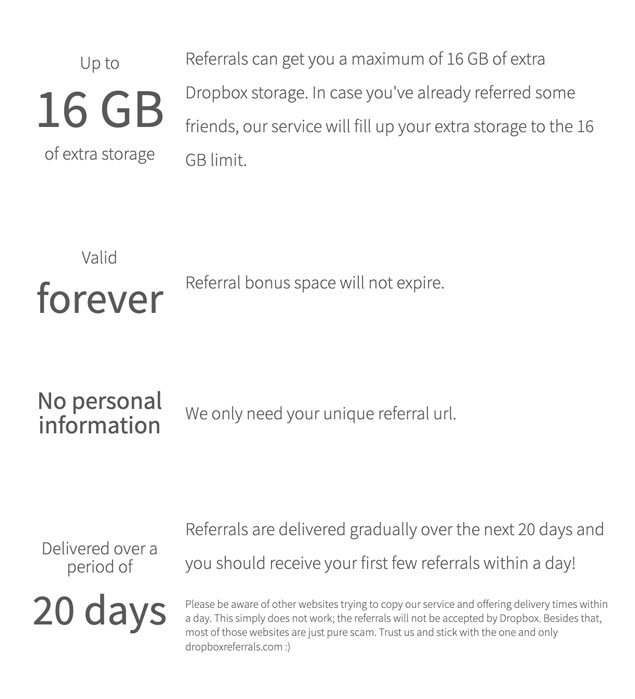
The numbers speak for themselves:
- 100,000 registered users in September 2008
- 4 million registered users in January 2010, after launching their referral program
- 400 million registered users in June 2015
Lessons learned:
- Work on your product’s quality, delivery, and customer support first. That will make your brand worth recommending.
- Choose the right discounts and incentives to get more referrals.
- Ensure those incentives are worth it.
3. Offer Loyalty Programs
These customer retention programs help people gain rewards or discounts if they continue purchasing your products. The results are multi-fold:
It increases the repeat customer rate: Loyalty programs increase brand recall and make people feel part of a family. These people will become your most authentic brand ambassadors, recommending your brand to their friends and family. These new customers are likelier to become repeat buyers if you have already created that sense of community.
You increase the average order value: Discounts can increase average order values. That’s why Black Friday exists – companies profit from this holiday.
You increase the customer lifetime value: These discounts and incentives will make people buy more frequently, and since the order value is increased, the customer lifetime value is also higher.
You decrease churn rates: Your existing customers will have palpable incentives, a.k.a. reasons to stay loyal to your brand. This solution is perfect, especially if your competition sells cheaper products of similar value.
The Atlas Coffee Club has devised a rewards program that looks like this:
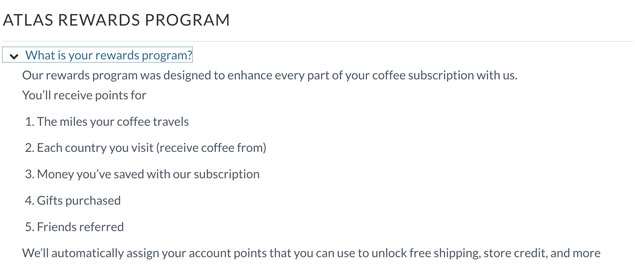
This example is excellent because it shows how a DTC brand retailing something as banal as coffee can stand out:
- Come up with a unique selling point: Coffee from different providers worldwide.
- Monetize that selling point: Use incentives to motivate people to purchase more of that product.
Lessons learned:
- Use gamification: Think of points and rewards of different value that your customers can earn. Make sure people don’t have to work too hard or for too long until they gain specific rewards.
- Consider what people can redeem their points for: Good ideas include shipping discounts, gifts, or lifetime discounts.
4. Use UGC to Create Desire
User-generated content has been shown to catch people’s attention and increase their purchase intentions.
If you leverage that UGC correctly, you can create a desire for your brand which stems from social proof. You also alleviate people’s worries about your products if they can see their peers happily using them.
That means:
- You can get more repeat customers: Shoppers will stay loyal to your brand if they feel they have become part of a community.
- You decrease the churn rate: After all, people want to stay part of that community of like-minded shoppers.
- You increase purchase frequency: When purchases stall, send a savvy UGC marketing email informing shoppers of your new offers.
Vivian Health is an app that allows nurses to find jobs. The app has partnered with several content creators who have already used this app to find nursing gigs:

Travel pediatric nurse Alex RN is an Instagram micro-influencer who often talks about his life and the perks of travel nursing. As such, he produces highly credible content that generates a lot of engagement. His followers ask him questions, and Alex always responds thoroughly.
As a result, more people will get the Vivian Health app. They will also become repeat customers and recommend this app to their loved ones because they feel part of a community.
Here’s another example:

Nassau Paradise Island features pictures from real-life customers in its marketing emails to elicit desire. That way, tourists can return to this destination in the Bahamas again, and, of course, they will use this particular website to book accommodations and tours.
Lessons learned:
- Start from your prospects’ needs when building your UGC campaign.
- Your messages must address the main problem that interferes with your customer retention rate.
- Leverage social media, your websites, and marketing emails when posting UGC
5. Celebrate Anniversaries
Celebrating anniversaries and other milestones with your longest-standing customers increases brand loyalty and brings you to the forefront. Besides, 61% of shoppers actively expect you to celebrate their milestones.
This strategy:
- Decreases your churn rates: Sometimes people look elsewhere without being disappointed in your brand. That can happen because they want to try something new or have received another recommendation. However, celebrating your shared milestones puts you back in the limelight. And helps them remember why they were loyal customers.
- Increases order frequency and value: At least at the moment, this strategy will help your existing customers renew their orders because they feel cheered on. Plus, you would have also reminded them where their loyalties lie.
Remember: Don’t simply focus on large milestones like yearly anniversaries. Celebrate the little things along the way, too.
For example, Grammarly sends personalized weekly insights into their customers’ performance:
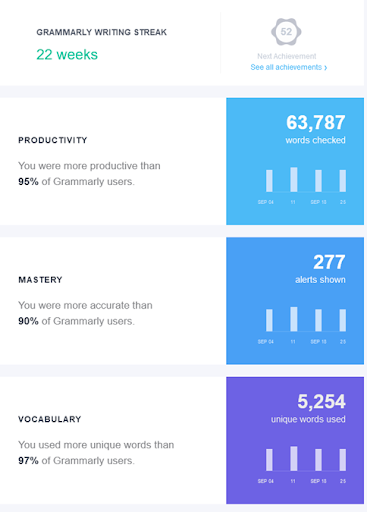
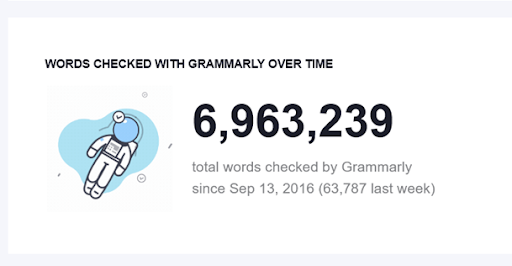
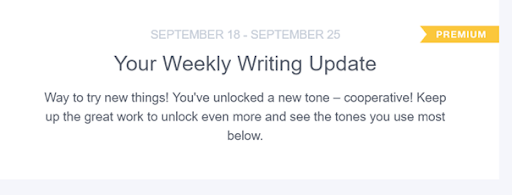
Even better, they allow users to share these results on their Facebook and Twitter accounts.
Lessons learned:
- Focus on small wins to keep people from looking at your competitors.
- Allow customers to share the good news on their social media.
- Personalize your messages.
6. Check-in With Former Clients
Getting back in touch with former one-time clients may not increase the customer retention rate directly. However, it has long-term effects.
Take this case:
You send a personalized email or make a phone call to one of your ex-customers. You ask whether you can help them with anything (e.g., another product) or refer them elsewhere.
This strategy:
- May have some of your former customers come back to your brand – for example, if they forgot to renew your subscription
- May convince some of these customers to try some of your other products
- Gives you access to specific insights into why these people quit buying your products. Use this feedback to improve your products, service, or communication.
Prompts to unsubscribe requests are a unique subcategory. These prompts are sent right when someone becomes an ex-customer, so you still have some chance of reconverting them. If not, you can prove your brand useful and loyal.
Here’s Beta List’s example:
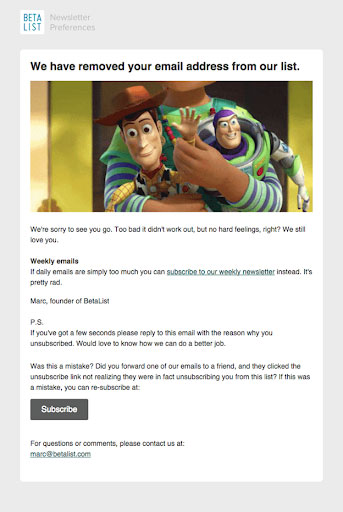
Lessons learned:
- Don’t burn bridges with customers who decide to take a break.
- Try to understand their reasons for breaking up with you.
- Send them personalized messages, keeping the tone conversational.
7. Stand Apart From the Competition
Standing apart from the competition guarantees more repeat customers from the onboarding stages. Besides, having a stellar product with a unique selling point that proves indispensable to your customers leads to word of mouth. Therefore, you can attract even more loyal customers in the long term.
Basically, this customer retention strategy helps you:
- Increase retention rate
- Increase the number and value of purchases
- Decrease the churn rate
Here’s what gives you a competitive edge:
- Unique selling point
- Quality service
- Strong onboarding experience
- Fast delivery
- Seamless returns
For example, Body Groove offers a unique selling proposition compared to other fitness apps. It allows people to dance to the beat according to their fitness level, space, and specific needs. Although the app has over 600 routines, these workouts are less structured compared to the industry norm.
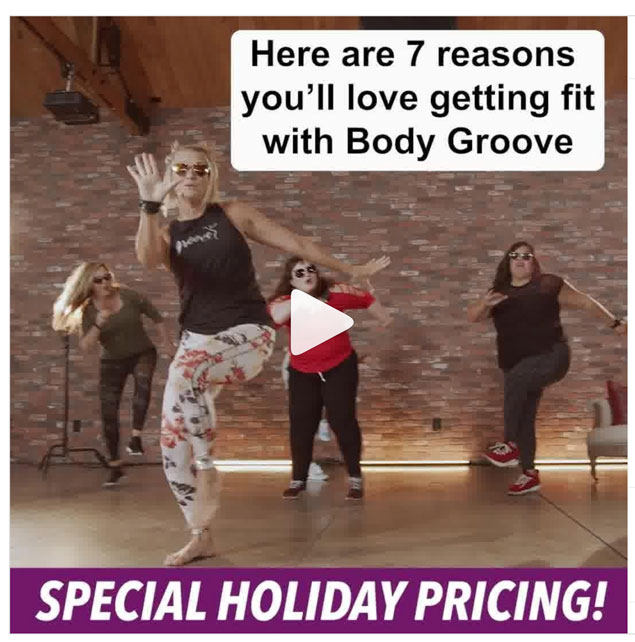
8. Stay Top of Mind on Social Media
Staying top of mind on social media is an excellent strategy to increase customer retention on all fronts. After all, keeping close contact with your customers helps you develop an intimate relationship, and that relationship is the basis of their:
- Future recommendations
- Increased purchases
- Frequent buys
- Loyalty in the face of future PR crisis (and therefore, decreased churn rates)
Cédric Grolet, a Parisian pastry chef at Le Meurice, knows how to keep desire levels high for his pastry. His tactic is simple: he posts authentic UGC on social media. Of course, his posts are a professional blend of colors and sound to elicit that desire. And his signature move is biting from his fresh, delicious concoctions at the end of each video:

That keeps Cedric Grolet top of the mind of his exclusive clientele, who purchase more mouthwatering pastries and place higher-value orders.
Conclusion: How to Start Your Customer Retention Plan
To start your customer retention rate, you need a good plan. Hopefully, this article showed you where to start making that plan and the best tactics you can use.
So, remember to always begin by analyzing your current situation.
Look at all the customer retention rate metrics and set SMART goals to adjust the low-rank variables. Then, choose one of the strategies discussed above – or a mix of them depending on those objectives.
Remember to monitor the progress of your campaign carefully. If you don’t reach the desired results, reassess and adapt your strategy.
The easiest way to do this is using an analytics tool such as SocialPilot. With its social media analytics, you clearly understand how your content is performing. It also helps you understand your audience better & analyze growth patterns to create engagement strategies. Moreover, you can download detailed PDF reports of major social media platforms that you can quickly share with clients. Take a look at Facebook’s analytics below.

More importantly, remember that a high retention rate starts with good products, stellar service, and quality relationships.
So, work on those variables before implementing any other strategy, and your customer retention rate will improve significantly.
